Are you looking for innovative and reliable ways to attract gluten-free consumers? With up to 13% of the population experiencing some sensitivity to gluten-containing products, offering gluten-free dining options is more important than ever. Whether a customer needs to avoid gluten because of a health condition or simply wants to eat gluten alternatives, your business can benefit greatly by providing gluten-free menu items.
We’ll go over the best ways to cater to gluten-free customers below by explaining gluten-free ingredients, how to avoid cross-contamination, how to cook gluten-free and gluten-free safety training. These gluten-free restaurant ideas will help you keep your customers happy and feel comfortable with their dining experience.
Table of Contents
- Understand Catering to Gluten-Free Customers
- Know the Best Foods for Gluten-Free Customers
- Watch out for Cross-Contamination
- Learn How to Cook Food for Gluten-Free Customers
- Train Staff How to Cater to Gluten-Free Customers at a Restaurant
Use SAN-J Sauces to Complete Your Gluten-Free Dishes
1. Understand Catering to Gluten-Free Customers
The first step to providing quality gluten-free dining services is recognizing the various motives for following a gluten-free diet. Knowing all the possible reasons a customer may adhere to this diet will help you understand the potential dangers involved and treat the issue more seriously.
Although eating gluten-free is quickly becoming a larger trend across the nation, a gluten-free diet cannot be equated with other diets, such as low-fat, low-carb or paleo. These other diets can be a choice for health concerns but are generally dietary preferences. Being unable to consume gluten can be a serious medical condition for some people.
While many people mistakenly believe a gluten-free diet is simply a healthier way to eat, consuming gluten can cause a range of health problems for those with a gluten-related condition. These are some of the health complications that can lead someone to adhere to a gluten-free diet:

- Celiac disease: About 3 million Americans have celiac disease — an autoimmune condition in which consuming gluten triggers an autoimmune response that attacks the body’s own intestinal lining.
- Non-celiac gluten sensitivity: Up to 40 million Americans are believed to have non-celiac gluten sensitivity. Having this condition means consuming gluten causes unpleasant symptoms that can be avoided by sticking to a gluten-free diet.
- Irritable bowel syndrome (IBS): For some people with IBS, following a gluten-free diet can resolve their symptoms.
A restaurant customer with any of the medical conditions listed above depends on a dining establishment to meet their dietary needs. Even trace amounts of gluten can lead to various side effects that no restaurant owner wants their consumers with a gluten sensitivity to experience, like headaches or stomach pain.
2. Know the Best Foods for Gluten-Free Customers
Now that you understand the gravity of catering to gluten-free customers, learn which foods are suitable for a gluten-free diet. Gluten itself is a protein found in most grains. It’s most commonly found in wheat, barley, rye and oats unless they are specifically designated gluten-free.
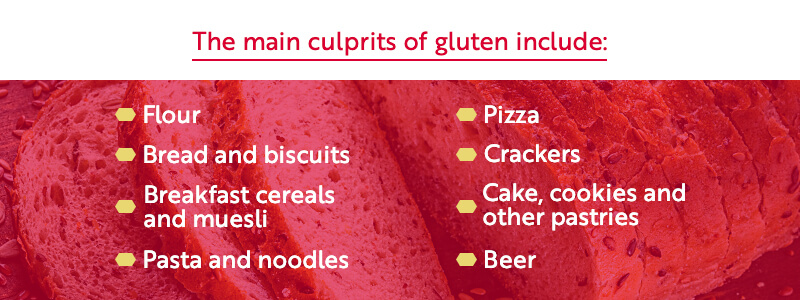
The main culprits of gluten include:
- Flour
- Bread and biscuits
- Breakfast cereals and muesli
- Pasta and noodles
- Pizza
- Crackers
- Cake, cookies and other pastries
- Beer
Although gluten is most commonly found in grains, it can easily sneak its way into other foods. It’s imperative to examine the ingredient label of everything your restaurant puts into its recipes. You should avoid using any ingredients with a “may contain wheat or gluten” warning label because it is not worth the risk. Also, keep in mind that “wheat-free” does not mean the same thing as gluten-free.
When checking your ingredients for gluten, look out for these sources of the protein:
- Couscous
- Certain stock cubes
- Gravy mixes
- Some herbs and spice blends
- Soy sauce, unless marked as a certified gluten-free product
- Worcestershire sauce, malt vinegar and sometimes ketchup or English mustard
- Certain ground meats like sausages and burgers
- Select meat substitutes like seitan
- Brewers yeast
- Dry roasted nuts
- Most types of potato chips, unless otherwise specified
- Certain salad dressings
- Some types of chocolate
In addition to using gluten-free versions of the ingredients listed above, try incorporating more naturally gluten-free ingredients into your restaurant’s recipes. Some of the most common and versatile naturally gluten-free foods include:
- Rice
- Quinoa
- Potatoes
- Polenta
- Lentils
- Corn flour
- Beans
- Raw seeds and nuts
- Fresh fruits and vegetables
- Meat and fish
- Plain tofu
- Tamari — some Tamari brands may contain traces of wheat, so choose certified gluten-free Tamari
- Milk, cream, buttermilk and butter
- Most cheeses
- Yogurt
- Tapioca
- Sorghum
While these ingredients are naturally gluten-free, you will still want to check the label to make sure they were packaged in a gluten-free facility.
3. Watch out for Cross-Contamination
Once you’ve acquired your gluten-free ingredients, you will need to store them correctly to ensure they do not become cross-contaminated. Cross-contamination refers to the process by which a bacteria or other type of microorganism gets unintentionally transferred from one substance to another and causes a harmful effect.
In terms of gluten, cross-contamination occurs when a gluten-free substance comes in contact with traces of gluten and becomes contaminated with the protein itself. A gluten-free food that has been in contact with a gluten-containing food becomes unsafe for anyone with a condition like celiac disease to eat.
To prevent this, you will need to take special measures when storing your ingredients, preparing your dishes and cleaning your cooking equipment.
Ingredient Storage
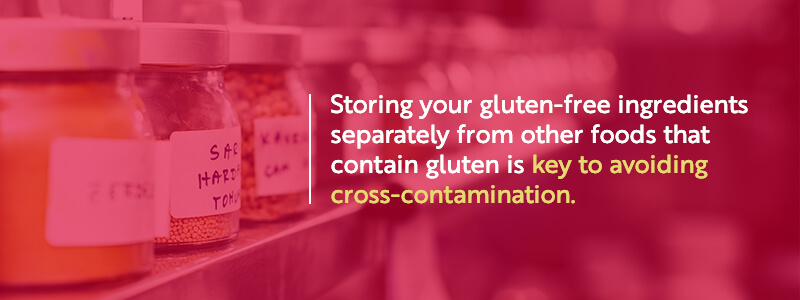
Storing your gluten-free ingredients separately from other foods that contain gluten is key to avoiding cross-contamination. Create a designated section for gluten-free ingredients, and be sure to keep opened packages tightly sealed and clearly labeled to prevent any unintentional crossover. You might also color-code your storage methods for a clear distinction.
You will want to make the gluten-free shelves of your ingredient storage area higher than the shelves reserved for gluten-containing ingredients. Keeping the gluten-free ingredients above the other ones will ensure no traces of the protein accidentally fall into gluten-free ingredients in the case of leaks, spills or ripped packaging.
Get into the practice of keeping the information for all ingredients on file in case any customers have questions about the contents of your restaurant’s recipes. Having the details of your restaurant’s ingredients readily available can help avert any potential health issues and give uncertain guests peace of mind.
Food Prep
You will need to take special precautions when preparing gluten-free dishes to ensure there’s little to no risk of cross-contamination. Set up separate surfaces as prep areas for gluten-free food to keep crumbs or particles away from the gluten-free ingredients.
If you’re baking any foods from scratch, have physical barriers or extra distance between your dedicated gluten-free food prep surface and other areas because flour can become airborne. Of course, you will need to use clean chopping boards, pots, pans, knives and other utensils within your gluten-free prep area, as well.
Consider investing in a separate set of utensils for use only in the gluten-free prep zone. Even after being cleaned, kitchen utensils can still have traces of gluten on them. Cheese graters, colanders, ice cream scoops and pizza cutters are especially difficult to clean, and a thorough washing might still leave particles on them.
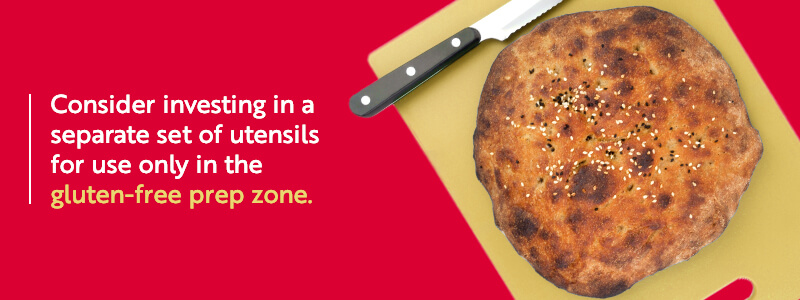
If you decide to get a separate set of gluten-free utensils, make it obvious the utensils are for gluten-free food prep only. Color-code the utensils, purchase a different set from your others or use durable labels that can withstand repeated washings. Whatever you do, have a clear distinction between the regular and gluten-free utensils to decrease the chances of anyone accidentally using the wrong one.
Having a separate gluten-free food prep area and utensils extends to having gluten-free equipment. You can’t put gluten-free items directly onto shared oven racks, grills or fryers that are used for breaded items, so you’ll need separate cookware for gluten-free food. Using clean oven trays and tin foil or greaseproof paper can also help keep gluten-free foods safe.
Once the gluten-free food is prepared, make sure the finished product gets placed on a separate plate or platter away from any gluten-containing dishes. If your kitchen is not strictly gluten-free, consider making the gluten-free items for the day first then preparing the regular meals. Be sure to cover the finished gluten-free dishes with cling wrap or place them in another room before starting the cooking process for gluten-containing recipes.
Finally, try to bulk prep gluten-free foods whenever possible. The base of some recipes can be prepared in bulk before any gluten-containing ingredients are added, which means you can double or triple the recipe before separating it into gluten-containing and gluten-free batches. For instance, you can make large batches of a salad before portioning it out and adding croutons to only half of the plates.
Equipment Cleaning
Clean equipment is crucial to keeping your kitchen safe for gluten-free guests. Having separate gluten-free prep surfaces or utensils does not negate the need for thoroughly cleaning your kitchen equipment after each use. Wash all mixing bowls, pots, pans and utensils in hot water and detergent before rinsing in clean water to minimize the risk of cross-contamination.

Along with washing your kitchen equipment, you will need to wipe down your kitchen surfaces after each use to ensure your cooking spaces are sanitary. Keep a bucket of soapy water and a clean dish rag handy to wipe off surfaces quickly during peak hours. Once the kitchen is less busy, you can conduct a more thorough cooking station cleaning.
You likely take those cleaning steps, anyway, to maintain a pristine kitchen. Add being mindful of gluten cross-contamination to your usual routines to help cater to a larger customer base.
4. Learn How to Cook Food for Gluten-Free Customers
One of the easiest and least stressful ways to run a gluten-free kitchen is to prepare only gluten-free recipes. By using naturally gluten-free ingredients, you can make gluten-free dishes without having to make any substitutions. Focusing on naturally gluten-free meals suitable for everyone will make your kitchen prep significantly simpler and save you from having to make separate dishes.
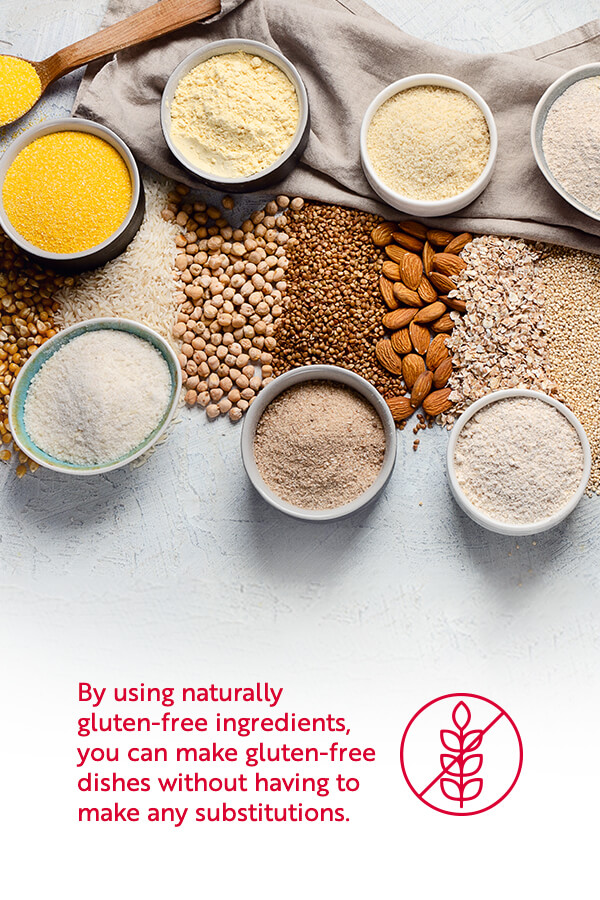
Even if you offer a combination of gluten-containing recipes, you should still have alternatives free of gluten. In general, gluten-free recipes are surprisingly inclusive and appeal to a wide variety of consumers. You can find plenty of tasty, naturally gluten-free recipes that appeal to all foodies. From South American cuisine to Asian-inspired dishes, gluten-free cooking comes from locations worldwide.
Although there’s no shortage of delicious gluten-free recipes, learning new cooking techniques can be challenging. Because gluten often works as a binding agent in food, it can be difficult to achieve the right texture when preparing dishes without it. Luckily, there are lots of mouth-watering and easy gluten-free recipes to help you get started.
Here are 10 quick and easy gluten-free recipes that are sure to inspire you to have your customers coming back for more:
- Turkey teriyaki lettuce cups: Keep up with both the lettuce wrap fad and gluten-free needs by serving turkey teriyaki stir fry in lettuce cups. This recipe douses a delicious mix of ground turkey and fresh vegetables in mildly sweet SAN-J Teriyaki Sauce. The result is a refreshing lettuce wrap, filling enough for guests to enjoy as an appetizer or a main course.
- Lemony red jacket potatoes: As a naturally gluten-free ingredient, potatoes make the perfect side dish for any gluten-free meal. This lemony red jacket potatoes recipe makes plain old potatoes pop by incorporating SAN-J Sweet & Tangy Sauce to create a light glaze. Roasting the potatoes in the oven gives them a nice crisp texture that will have customers craving them again and again.
- Oven-roasted Korean BBQ wings: Thanks to these oven-roasted Korean BBQ wings, your gluten-free customers can enjoy a crisp crunch and the bold flavors of SAN-J Korean BBQ Sauce without worrying about gluten-containing ingredients. Roasting the wings in the oven instead of deep-frying them also makes this recipe a bit healthier than most traditional ones.
- Bacon and pineapple pork roast: Offering an irresistible sweet and salty flavor combo, this bacon and pineapple pork roast will make your customers’ taste buds sing. By wrapping a savory pork loin in salty bacon and dousing it in SAN-J Sweet & Tangy Sauce, you can create a perfectly seasoned roast that delivers a symphony of flavor with each bite.
- Citrus glazed tilapia: It’s hard to name a better flavor duo than fresh seafood and citrus. By incorporating orange juice, honey and orange marmalade, this citrus glazed tilapia recipe inspires the taste of sunshine and reminds diners of a relaxing day on the beach. Using a splash of SAN-J Tamari Lite 50% Less Sodium in the glaze evens out the sweetness of the citrus without adding an overpowering saltiness to the seafood.
- Thai peanut chicken stir fry: A good stir fry is a certain crowd-pleaser. This Thai peanut chicken stir fry allows you to capture the beautiful flavors of Thai cuisine. By using SAN-J Thai Peanut Sauce, you give your stir fry the perfect peanut flavor in an instant. Serve the stir fry alongside sticky rice, and you’ve got a meal gluten-free customers will clamor for.
- Sweet and tangy turmeric quinoa salad: Turmeric is a show-stopping spice that can define a dish. This sweet and tangy turmeric quinoa salad is the perfect gluten-free side because it pairs the earthy spice of ground turmeric with lighter hints of coconut flakes and orange zest. Adding raw cashews for texture and SAN-J Sweet & Tangy Sauce for flair sets this quinoa salad apart from any other side dish.
- Orange chipotle grilled chicken with citrus salsa: Any recipe that cuts the spice of chipotle chili powder with citrus flavors is a winner. But this orange chipotle grilled chicken with citrus salsa recipe stands out as a champion. The recipe’s use of fresh herbs, spices, lime juice and SAN-J Orange Sauce gives it a unique taste that perfectly complements the chicken’s smoky char-grilled flavors.
- Mongolian beef and shishito peppers: Beef is one of the most flavorful and delicious naturally gluten-free ingredients. This Mongolian beef and shishito peppers recipe balances beef’s natural richness with the sweet and slightly smoky taste of shishito peppers alongside sweet and savory SAN-J Mongolian Sauce. Serve this show-stopper with a side of sticky rice and steamed broccoli to make it a meal to remember.
- Maple Tamari roasted Brussels sprouts with candied bacon: Ever since restaurants began dressing Brussels sprouts up with bacon, the humble green veggie has become all the rage. This sprouts recipe turns the vegetables into a culinary masterpiece by sweetening them up with maple syrup. A touch of saltiness comes in from the candied bacon and a layer of savory flavor from SAN-J Tamari
5. Train Staff How to Cater to Gluten-Free Customers at a Restaurant
If your restaurant is going to offer gluten-free options, you must ensure that every member of your staff knows how to handle gluten-free orders properly. Required staff training should include a special segment on food safety and how to serve customers with gluten-free needs. Along with this initial training, staff members should undergo regular refreshers to help them avoid mistakes and feel more confident when answering customers’ gluten-related questions.

Your mandatory staff training on gluten-free procedures should include the following:
- What gluten-free means and why sticking to a strict gluten-free diet may be medically necessary for some customers
- Why a gluten-free order should be treated seriously like an allergy order, not a mere dietary preference
- Guidelines to ask every customer whether they are gluten-free before taking their order
- Which ingredients contain gluten, especially the less obvious ones, and which do not
- What cross-contamination is and how to prevent it
- Instructions to always wash their hands with soap and water and change their prep gloves before handling gluten-free ingredients or dishes
- Directions to always make a gluten-free dish fresh rather than removing a gluten item from a dish and serving it as gluten-free
Because gluten can cause serious medical consequences, do not advertise your services as gluten-free if you or your staff are unable to commit to following appropriate safety protocols. Be honest about what your restaurant can provide, and do not make promises you can’t keep.
Offering gluten-free items without specifically labeling them as gluten-free is a great way to stay up on the gluten-free trend without risking anyone’s health. Here’s how you and your staff can cater to gluten-free customers without guaranteeing your food is gluten-free:
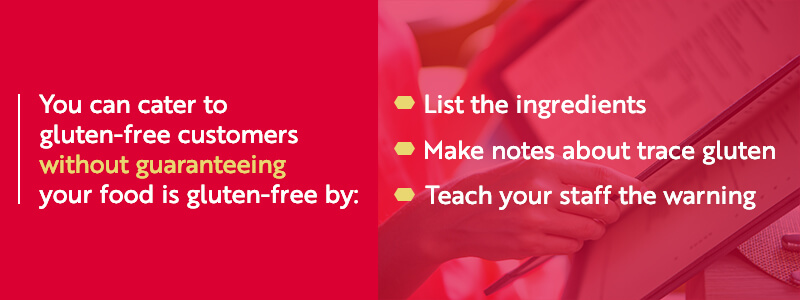
- List the ingredients: Provide a list of all the ingredients in each dish on your menu. Seeing all of a dish’s ingredients written out description-style makes it easier for gluten-free individuals to weigh their options.
- Make notes about trace gluten: Make a clearly visible note on all your marketing materials that you can’t guarantee your restaurant’s dishes will be free of trace gluten.
- Teach your staff the warning: Train your front-of-house staff members to state that same warning whenever a customer asks about your gluten-free services.
Following these guidelines instead of branding your restaurant as gluten-free gives you the flexibility to provide gluten-free options without holding you responsible for eliminating gluten altogether. If you can offer truly gluten-free services, you will earn a loyal customer base of those who are constantly searching for reliable gluten-free restaurants.
To ensure your restaurant’s kitchen practices and menu items are safely gluten-free, consult with a professional dietician about your restaurant’s operations.
Use SAN-J Sauces to Complete Your Gluten-Free Dishes
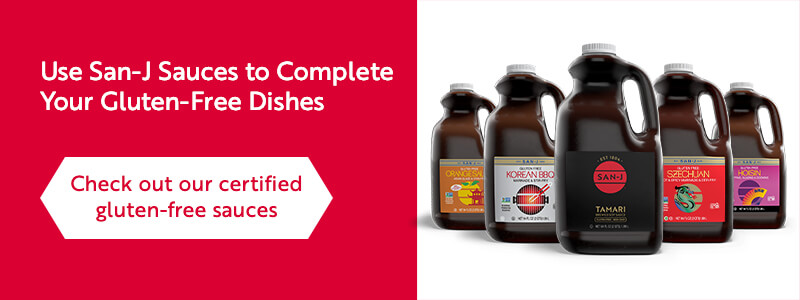
If you’re trying to cater to gluten-free customers, let certified gluten-free sauces from SAN-J be your secret ingredient. When serving gluten-free menu items, you need a gluten-free brand you can trust to help serve your customers. We offer a range of products certified gluten-free by the Gluten-Free Certification Organization so you can be confident you’re using reliable ingredients at your business.
SAN-J’s popular Tamari Gluten Free Soy Sauce is made with 100% soy and no wheat. Due to higher soy protein concentration, it has a richer, complex flavor with over 30% more umami than typical soy sauce. Our Asian Cooking Sauces are versatile and work great for multiple applications such as marinating, grilling, stir-frying, and dipping. Check out our wide variety of tasty certified gluten-free sauces to liven up your gluten-free cooking today.
Back to Top

